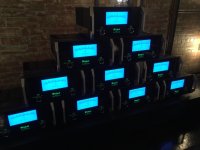- Thread Author
- #1
I just stumbled across this in the MC452 download section. It's a connection diagram for stereo and bi-amp configuration. Pretty cool I think.
http://www.mcintoshlabs.com/us/Prod...McintoshDocumentMaster/us/mc452cd1and2-01.pdf
It does show that basically one amp is setup for the highs and the other amp is used for the lows. Each amp has one output per channel and is used to daisy chain the next amp via its output to input.
It was recommended to me to basically use one amp per speaker utilizing both preamp outputs per channel which is vertical bi-amping (?).
I think the diagram depicts horizontal bi-amping.
That diagram sort of rekindled my interest. Again I realize it's only passive bi-amping configured this way, but McIntosh does seem to condone the practice. Whether it's to sell more gear or honestly give you better performance is, I assume, a matter of actually trying it. Thoughts?
http://www.mcintoshlabs.com/us/Prod...McintoshDocumentMaster/us/mc452cd1and2-01.pdf
It does show that basically one amp is setup for the highs and the other amp is used for the lows. Each amp has one output per channel and is used to daisy chain the next amp via its output to input.
It was recommended to me to basically use one amp per speaker utilizing both preamp outputs per channel which is vertical bi-amping (?).
I think the diagram depicts horizontal bi-amping.
That diagram sort of rekindled my interest. Again I realize it's only passive bi-amping configured this way, but McIntosh does seem to condone the practice. Whether it's to sell more gear or honestly give you better performance is, I assume, a matter of actually trying it. Thoughts?
View attachment mc452cd1and2-01.pdf

